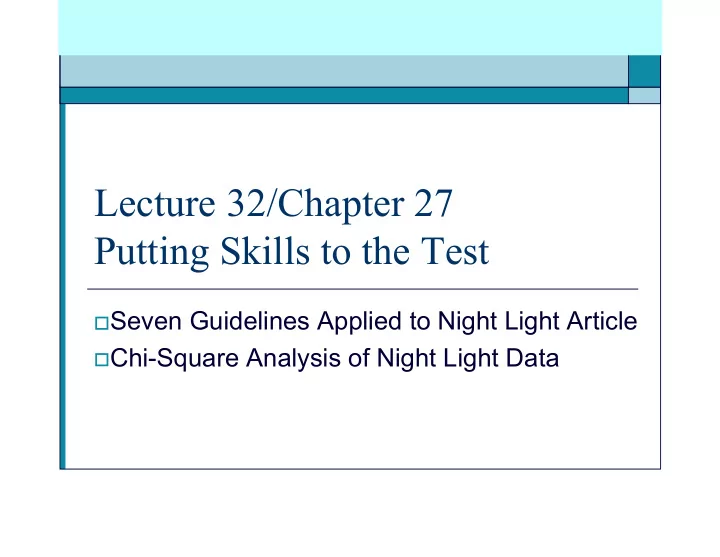

Lecture 32/Chapter 27 Putting Skills to the Test Seven Guidelines Applied to Night Light Article Chi-Square Analysis of Night Light Data
Seven Guidelines (Review) Step 1: Determine if study was sample survey, experiment, obs study, census, or anecdotes. Step 2: Consider 7 Critical Components (details). Step 3: Check for “Difficulties and Disasters” (sampling p. 69, exp. p. 90, obs. studies p. 96) Step 4: Is info complete? If not, find original? Step 5: Do results make sense? Step 6: Are alternative explanations possible? Step 7: Do results affect your attitude/lifestyle?
Seven Critical Components (Review) Source of research and funding 1. Researchers who had contact w. participants 2. Individuals studied, how they were selected 3. Variables studied [measurements, questions] 4. Setting (time, place) 5. Confounding variables [differences besides 6. factor of interest] if causal relationship is claimed Extent or size of claimed effects/differences 7.
Example: Night Lights & 7 Guidelines Background : Night Lights Bad for Kids? Question: How does each guideline apply? Response: Step 1 (design): retro obs study Step 2 (7 Components): #1 source/funding: (reputable?) _________________________________________________ #2 researchers having contact w. participants: ______________________ #3 individuals/how selected: ________________________________________________
Example: Night Lights & 7 Guidelines Response: Step 2 (7 Components) continued: explan: ______________________________ #4 variables: response: ____________________________ #5 setting: ______________________________________ #6 confounding variables (diffs in groups compared): ____________________ #7 magnitude/quantify effect: ____________________
Example: Night Lights & 7 Guidelines Response: Step 3 Difficulties? (Obs. p. 96) Confounding variables? 1. __________________________________________ _____________ Extending results inappropriately? 2. Using the past as a source of data? 3. _________________________________________
Example: Night Lights & 7 Guidelines Response: Step 3 Difficulties(sampling p.69) Using the wrong sampling frame? 1. ___________________________________________ ________ Not reaching individuals selected? 2. Having a low response rate? ________ 3. _______ Volunteer/self-selected sample? 4. _______ Convenience or haphazard sample? 5.
Example: Night Lights & 7 Guidelines Response: Step 4 Information complete? ______ Step 5 Do results make sense? _____________________________________ Step 6 Alternative explanation? _____________________________________ ______________ Step 7 Results’ impact on you?
Example: Night Lights & Chi-Square Background : Article reports % myopic: darkness 10% of 172; nightlight 34% of 232; lamp 55% of 75 Question: What are the observed counts? Response: Myopic OK Total Darkness 172 Nightlight 232 Lamp 75 Total 479
Example: Night Lights & Chi-Square Background : We have table of observed counts. Question: What are the expected counts? Response: Obs M NM Total Exp M NM Total D 172 D 172 N 232 N 232 L 75 L 75 T 137 342 479 T 137 342 479
Example: Night Lights & Chi-Square Background : Observed and expected counts are Obs M NM Total Exp M NM Total D 172 D 172 N 232 N 232 L 75 L 75 T 137 342 479 T 137 342 479 Question: What is chi-square? Conclusions? Response: _____________________________________________
Recommend
More recommend